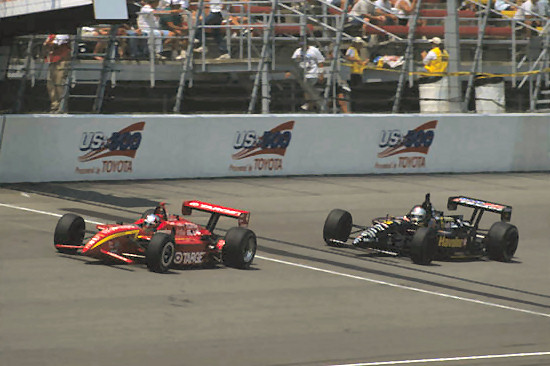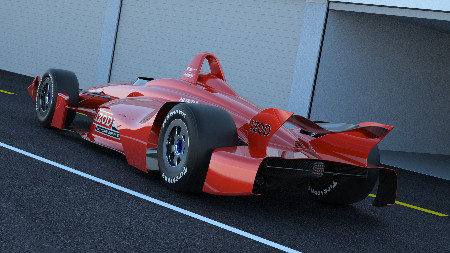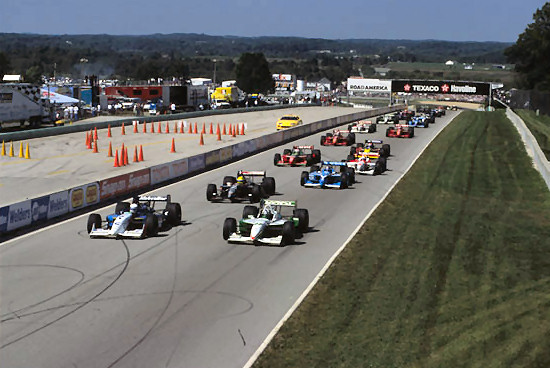The Way It Is/ An opportunity lost?by Gordon Kirby |
 Last week I discussed the problems with racing Indy cars on high-banked ovals with Bruce Ashmore. At the end of last week's column Ashmore said he believes IndyCar has made only minor incremental changes both in terms of crash safety and eliminating safety problems with the dreaded 'pack racing'. This week we explore more of Ashmore's analysis of the new Dallara and discuss what the correct formula should be for Indy cars.
Last week I discussed the problems with racing Indy cars on high-banked ovals with Bruce Ashmore. At the end of last week's column Ashmore said he believes IndyCar has made only minor incremental changes both in terms of crash safety and eliminating safety problems with the dreaded 'pack racing'. This week we explore more of Ashmore's analysis of the new Dallara and discuss what the correct formula should be for Indy cars.
First of all, most fans and all the drivers, past and present, want to see more power. The fans want the drivers to lift for the corners, use the brakes, then get back on the power and drive their cars, using their advantage in every area to cleanly execute a pass rather than droning around in packs straining for lap after lap to gain the tiniest advantage. Using the brakes and throttle to best effect is what automobile racing was all about for most of a century until NASCAR invented restrictor plate racing and the IRL followed suit with its squalid little formula. Personally, I think the classic CART car with tiny speedway wings was as elegant an Indy car as there's ever been. It worked well and put on a good show on all types of tracks with plenty of power--900 and upwards of 1,000 horsepower--to be able to pass and race back and forth. It was necessary to get out of the throttle for the corners and possibly use the brakes, then judiciously get back on the power. Ashmore believes the 2012 Dallara-Honda/Chevy/Lotus combination is only a small step in the direction of the old CART formula and falls far short of the objective. "They're trying to go somewhere else to create what was there before," Ashmore remarks. "Well, that's not right. Go back to what was there before. I'm sure you can attain what was there before if you go back to that formula. There was nothing wrong with it. So just re-run it." Ashmore has no doubts the power needs to be substantially increased.  © Paul Webb "You never hear the drivers talk today about how hard the cars are to drive. When I came into CART in the eighties every weekend was a struggle about how to keep the tires under the driver. You worked on that all the time trying to get the car through the whole race. But now everything is the same through the whole race. Everyone goes 'round and 'round at exactly the same speed with no change. They're not being strained. They're too easy to drive. And nobody can pass." It's true not only on oval tracks but also at road courses like Mid-Ohio and Infineon Raceway where passing is equally impossible and a procession ensues looking more like Indy Lights or GP2 cars than full-blooded Indy cars. Given that the new formula is likely to retain the same characteristics as the old one the new Dallara's bodywork has been designed to attempt to reduce the chance of wheels interlocking and cars flying. The idea was a key component in Ashmore's BAT design and he believes the new Dallara doesn't go far enough in this regard. "I've wanted to stop wheels interlocking and tread to tread contact for some time," Ashmore comments. "I worked on it and discussed it in the CART days and then in the IRL. When you're cornering at the maximum of the vehicle's grip as soon as the tires touch each other tread to tread one car lifts off the road and it goes sideways and then the crash happens. "They think they've made some steps on that but they've still designed a car with a flimsy front wing, a flimsy piece of bodywork around the front wheels and no bodywork behind the rear of the front tire. The front tire is still exposed so you can still have a tread to tread or interlocking wheel accident which is what starts the flying accident. And that will still happen with the new car. They think they've solved it because that was in their mandate. But if you look at what they've designed the bodywork is not strong enough to stop the start of the accident." Ashmore also believes not enough attention has been paid to the driver's seating position. "I think the drivers need to sit more upright so they don't crush the driver's spine when they crash," he suggests. "I don't believe the seat is that much different in the new Dallara. They've made a change but it's only a small step. It's not a big enough change. We knew that the CART car had a problem and we needed to sit the driver in a more upright position. "I know from the study I made to design our BAT car that the car you needed to make would not fit into an Indy car transporter. You need a more upright seating position and another four or five inches above the driver's head for the roll hoop and it's too tall to go into an Indy car transporter. It would have to go in a NASCAR transporter. But they specified the car had to fit in the current IndyCar transporter because the teams couldn't afford scrapping or modifying all their transporters.  © LAT USA Ashmore has a bleak view of the process that took place in last year's contest for IndyCar's 2012 car. He believes each of the contestants was used unethically by IndyCar and Dallara to produce the new car. "In my view the way they went about it was quite dishonest. All of us competing car builders had to sign our ideas away. All our ideas went into a pot and we had to sign a document saying that if we didn't win the contract they kept our ideas. "That's one thing, but the sad part is they awarded the contract to a racing car building company in Italy who are just building another in a range of racing cars. It's a lot like their other cars and they're not using all the ideas that we put forward. They're only scratching the surface and, as I say, making a five percent step. They completely ignored a lot of what we suggested. They've just done what they felt like. "All of our ideas and Lola's ideas and Swift's and the Delta Wing group's ideas went in and they took our ideas to make this new car. But they only took a small portion of them so that they've only made a five percent step. So what's the point?" Ashmore remains dismayed and deeply disappointed with the way the Iconic committee's decision unfolded. "I put my heart and soul into the design of a car that I believe they wanted to win the bid. I designed what I thought should have been the next Indy car and it could have been used as a rule book or it could have been used as a spec car. I offered it both ways. It would have been a spec car built in Indianapolis with Indianapolis companies and suppliers. Or it could have been used as a rule book. "We lost the bid because the winner put in a business plan, not a plan for the car. It was a building on Main Street in Speedway and a business plan for the build and supply of all the cars but nothing for the design of the car. The rest of us believed we were putting in a plan for the design of a car and that the winner would be the best design.  © BAT Motorsport Engineering Ashmore also believes IndyCar has set Dallara up for some difficult if not impossible budget-balancing. "They've been stuck to a budget," he says. "They've been told what price to sell the car for. People don't understand that when you dictate that you've got to have this carbon fiber chassis and carbon fiber wings and a lighter aluminum gearbox. They've dictated a lot of the more expensive items in the manufacturing but they've also dictated the sales price too. It's ridiculous. "If you really want to have a cheaper price and better product then let the rules be open about the materials. Maybe you would use a lot more steel fabrication and the weight would go up but it would be cheaper. I believe the weight they set was unrealistically light and the materials are unrealistically expensive, so they have to compromise." Ashmore is equally sure that IndyCar's 2012 engine rules are too restrictive. "If you look at the rules that they've saddled Chevy, Honda and Lotus with, they're going to build the same thing. Okay, there will be three different badges on three different engines but the rules are so tight that you can't make anything really different." Nor is he aware of much if any activity in the Dallara project from the American or Indianapolis racing industry's component manufacturers and suppliers. "The cars are being built in Italy and the gearboxes (Xtrac) are being built in England," Ashmore says. "I don't know anybody in America who's making components for that car which is very sad because IndyCar seem to have conned the government officials in Indianapolis along with the Indiana tax payers who ultimately are footing the bill for the grants to the team owners to subsidize the purchase of this new car, a car that was supposed to have had its components made in America."  © Paul Webb "You need to have a rulebook with a few simple rules," he says. "You've got to come up with something that reduces the downforce. The price will take care of itself because as soon as you've got competition in the pitlane one guy will figure out how to make a cheaper car and will outsell the other guy. That's what happened before in the CART days and that's what they need to do again. You need to have multiple chassis builders and multiple engine builders and you need to not run them on the tracks we know they don't work on." Ashmore is a big believer in IndyCar returning to America's great road courses and developing a schedule of races much like CART enjoyed at its height. "They need to go back to nice venues like Laguna Seca and Elkhart Lake," he comments. "The reason I thought CART worked so well was it had a very good mix of venues. The teams were owned by wealthy car owners and they wanted to go to nice places and they would bring along their friends who would bring along sponsors. So as the cost went up the sponsorship went up but there were nice places to go to. I thought it was really clever. "We went to Canada in Toronto and Vancouver and then when we went outside North America we went to Surfers Paradise in Australia. All of them were really nice places and attractive to sponsors. Almost every race was a nice race to go to. There were a few odd ones like the Michigan 500 but they thought they ought to race there because it was near Detroit. "It was fun and it worked, but you go in the paddock today and everyone is miserable. They don't have any sponsorship and they don't enjoy the cars or venues. They don't know why they're doing it." Ashmore reflected on how CART's many managers and marketing men told the teams and the car and engine builders through the organization's hedays that the fans turned out only to see the drivers. There was little or no appeal in the cars or engines claimed those many geniuses who helped drive CART into the ground. "When it was 1,000 horsepower and four engine companies were going at it and you had all the combinations of three different chassis and four engines we were always told that wasn't what the fans came to see," Ashmore recalls. "We were told they came to see the star drivers and we always wondered how true that was. We used to ask let's see what happens when everybody is driving the same equipment. Let's see how many fans you've got. I guess we have the answer to that today don't we?" We've witnessed a sad, inexorably silly and lethal story over the past fifteen years. The lack of leadership, technically and otherwise, has been stunning. And so it continues. |
Auto Racing ~ Gordon Kirby Copyright 2011 ~ All Rights Reserved |
